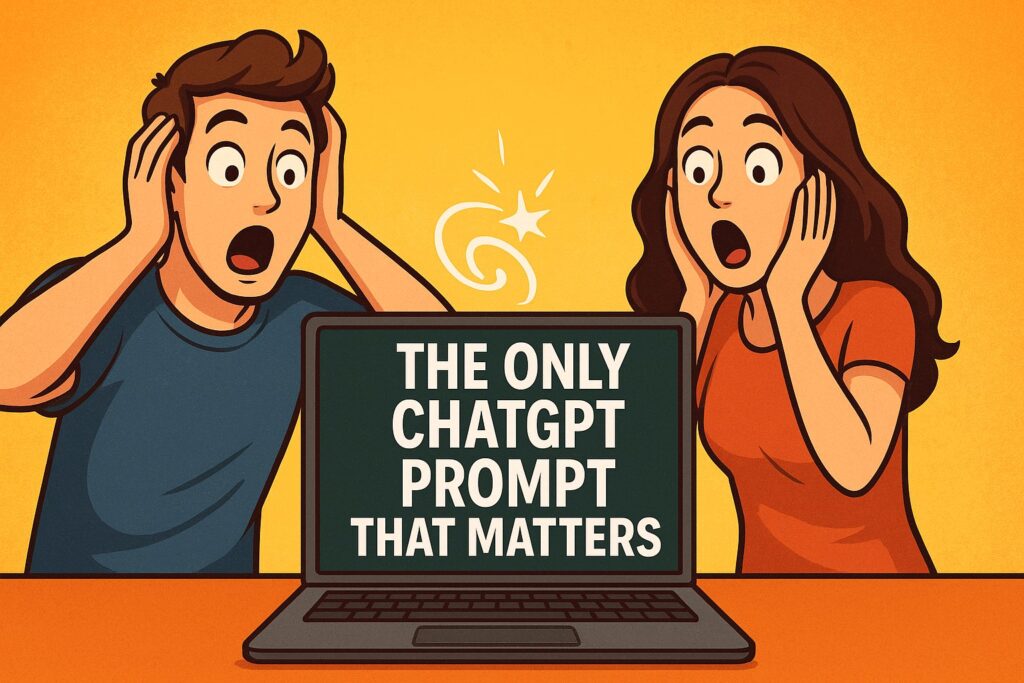For the last couple of years, AI trends is changing and I’ve been obsessed with one question: what makes a ChatGPT prompt truly effective? I’ve written, tested, and experimented with more prompts than I can count, but I always felt like something was missing.
Sometimes ChatGPT would hit my request on the first try. Other times, I’d receive half-baked responses that sent me chasing my tail in an endless cycle of rewrites and corrections. The contradiction made me want to dig deeper, because if AI should be considered intelligent, then why does it screw up so much?
That’s when I began searching not only for what I was asking, but how I was asking it. And after reducing through trial and error, I landed on something so simple it felt almost like cheating: Seriously, there’s only ChatGPT Prompt that actually matters.

Why Most Prompts Fail?
If you’ve been on social media, you’ve likely seen people sharing “magic prompts” for ChatGPT. They tend to be long, complicated and seem useful on the surface. Some even sounded like mini-essays, lists of rules, formatting requirements and unlimited instructions.
The problem? They rarely deliver.
I know from personal experience that these over-inflated prompts result in confusion rather than clarity. What they do, instead of making ChatGPT better at understanding me, is burden it. The replies I received seemed canned, robotic or totally not what I was looking for.
And that’s when I had a realization: the problem wasn’t that there were no details. It’s the lack of understanding. ChatGPT fills in the blanks of what I don’t say, and those assumptions often go off the rails of the answer.
The Breakthrough Moment
At one point, I asked myself a very simple question: What if instead of me overloading the prompt with details, I made ChatGPT do the work of clarifying questions?
That small shift in perspective changed everything and made effective ChatGPT prompts.
What I found was that the most potent prompts were not those in which I telegraphed to ChatGPT every single step. The ones where ChatGPT pumped the brakes, asked follow-up questions, and just made absolutely sure that it “got” what I was asking for before it dove in.
So I started to play with ideas on how to accomplish this. I tried dozens of different phrasing styles, sometimes overthinking it, sometimes stripping it away. It took a lot of trial and error and tweaking to get to something that worked consistently.
The Only Prompt That Matters
Here it is, the one prompt I now use in nearly every serious ChatGPT session, and it is really optimizing AI outputs:
Break down my request into key dimensions, highlight uncertainties, and ask every clarifying question necessary before answering.
That’s it. Simple. Less than 25 words. Easy enough to memorize.
And the impact? Huge. Instead of jumping to an answer, ChatGPT pauses, reflects, and converses with me before attempting to fulfill my ask. It’s the difference between an intern trying to guess how you’d like something done vs. a co-worker who pauses to say, “Um, wait, do you mean done this way, or that way?”
How to Write The Ultimate ChatGPT Prompt
Here we are not talk hypothetically like future of AI or how AI look likes in 2030. From a user’s perspective on ChatGPT prompt design, I will tell you that you can do so by avoiding bloated prompts and making it a simple but powerful ChatGPT prompt. For example, you can try this prompt on your ChatGPT and see the magic of this prompt:
Create HTML, CSS, and JavaScript where a ball is inside a rotating hexagon. The ball is affected by Earth’s gravity and the friction from the hexagon walls. The bouncing must appear realistic. Test physics simulation, code planning, and visual realism.
Why This Prompt Works Every Time? AI Conversation Tips
Through trial and error, or you say in my prompt engineering, I’ve learned that this one prompt is effective in achieving that because it does all three of the following things better than any other:
- It removes assumptions: ChatGPT no longer guesses. It prompts me for precisely what it should know, so the ultimate response fares sharper and more accurate.
- It taps into reasoning models: Modern AI thrives on reasoning, but only with enough room to reason. By inquiring about what it doesn’t know, the model ends up actually reasoning the task instead of making random inferences.
- It saves time: I don’t spend hours editing bad answers. With one strong back-and-forth up front, I get high-quality output faster.
How I Tested This
I didn’t want to take it on faith that this worked; I needed to test it in the real world. I tossed it at various use cases, by changing my ChatGPT questioning technique, such as:
- Content creation: When composing SEO articles, for example, this prompt allowed ChatGPT to inquire about my target audience, keyword focus and tone before putting pen to paper. The final pieces always looked more like what I had in mind.
- Strategy planning: Instead of nebulous business ideas, ChatGPT began asking, “Are you thinking about short-term gains or about positioning for the long term?” Enhanced by that degree of context, the answers turned out to be genuinely useful.
- Coding help: Now, rather than spewing out code that is less than specific, if I need to check what language, framework and version I’m using. That alone saved hours of debugging.
No matter what the context, the same pattern held: clarity before answers. So, always use clean and simple prompts to maximize ChatGPT performance.
Why Other Prompts Don’t Compare?
I’ve seen plenty of “frameworks” for ChatGPT prompts. Some people swear by long-winded scripts with bullet points, role-plays, and formatting rules. Others try to create one-size-fits-all prompts that sound like mini legal contracts.
But here’s what I’ve noticed: The longer the question, the easier it is for ChatGPT to lose the thread. More words do not mean more clarity.
What actually matters is conversation. The model has to speak to you before it speaks on your behalf. And that’s precisely what my prompt delivers time and time again.
Why This Matters for Writers, Marketers, and Creators?
If you’re using ChatGPT for SEO content, research or marketing (like me), then you’ll absolutely know how incredibly frustrating it is when you uncover responses like these. You’ve got deadlines to meet and no time to babysit the AI.
This prompt flips the process. Rather than correcting my messes later, I lead from the front. Well, for SEO in particular, it’s gold. When I’m writing against ChatGPT now, it asks me questions like:
- Which keywords are you prioritizing?
- What’s the target word count?
- Who’s the intended audience?
Once those details are set, the output aligns with my goals almost perfectly. That’s why I call it the only ChatGPT prompt that matters.
Also Read: Ultimate AI Glossary: Terms You Must Know
The Future of Prompting
As AI continues to march forward, I strongly believe the future of scripting will no longer involve rote memorization, nor will it involve bloated scripts. It’ll be about teaching AI to think with you, not for you.
This one prompt has a timeless quality, because it doesn’t rely on gimmicks or shortcuts. It trusts the most human way of solving problems: Ask a question first.
And that’s why, even as reasoning models evolve, I know this approach will stay relevant.
FAQs
The one that makes ChatGPT analyze your request, identify uncertainties, and ask clarifying questions before answering.
Because it removes assumptions, ensures context, and delivers more accurate, tailored results and this is the best way to optimize ChatGPT conversations.
Keep them simple, direct, and designed to trigger analysis, avoid bloated instructions.
Clarity, brevity, and the ability to encourage thoughtful responses instead of rushed answers.
Final Thoughts
After testing, failing, and iterating for months, I’ve arrived at a simple conclusion: the best ChatGPT prompt is not long, fancy, or flashy. It’s the kind that makes the model hesitate, ask for an explanation, offer one or even more thoroughly explain responses.
So, that’s all we have for you about how I found the only human-like interactions with ChatGPT Prompt that delivers consistently every time. We hope that this guide has helped you.

